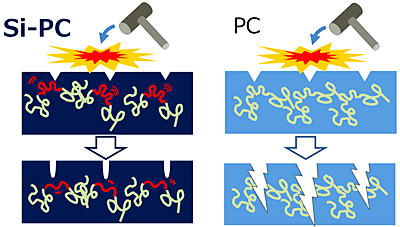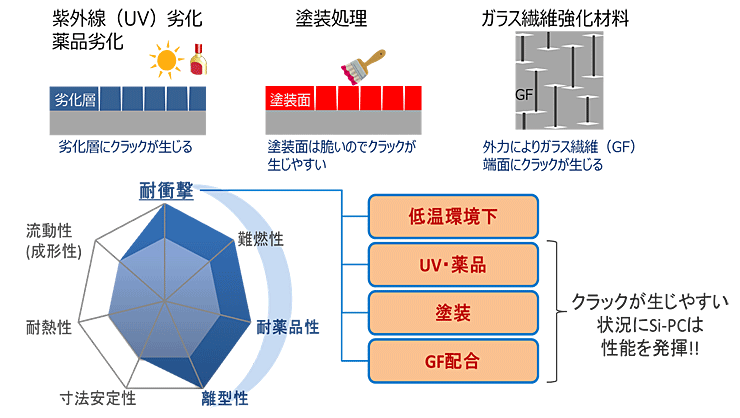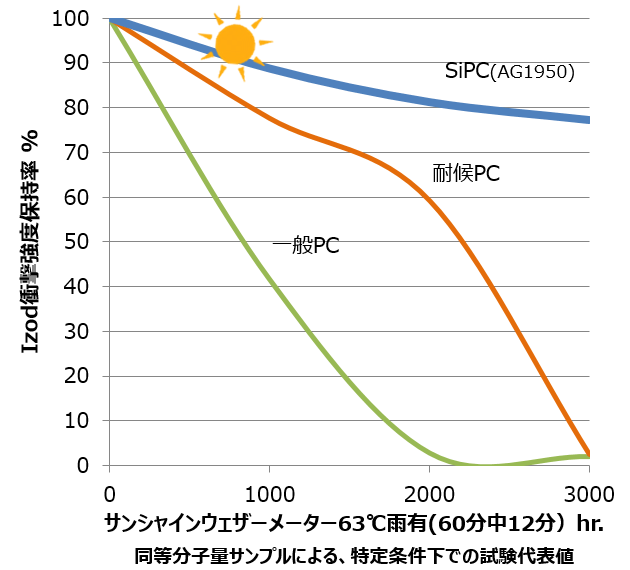TARFLON™ (polycarbonate resin), TARFLON NEO™ (siloxane copolymer polycarbonate)
What is polycarbonate (PC) resin?
Idemitsu Kosan has been researching polycarbonate since 1957. As a result, in 1969, we established the world's first proprietary continuous solution process manufacturing technology and began commercial production of "TARFLON™".
To further strengthen its competitiveness, the company licensed this proprietary manufacturing technology to Formosa Chemicals & Fibre Corporation of Taiwan, and consolidated production there in 2015.
Our company has developed copolymerization technology that utilizes our unique manufacturing technology. *1 and the compound technology we have developed so far. *2 We are focusing on the development and sales of siloxane copolymer PC resin (" TARFLON NEO™"), which utilizes these properties to further improve the low-temperature impact strength and weather resistance for outdoor use of PC resin, as well as optical grade products for use in light guide plates for LCD backlight units, diffusion covers for LED lighting, optical lenses, and automotive lighting (DRL; Daytime Running Light).
-
1. Copolymerization Technology
A technique for combining two or more types of molecules to produce larger compounds. -
2. Compound Technology
A technology that improves functionality by mixing other materials such as pigments and additives into the raw resin.
Features of TARFLON™
PC Resin TARFLON™ is an engineering plastic that has high transparency, self-extinguishing properties, and the highest impact resistance of any plastic.
It is used in a wide variety of fields, including optical discs, motorcycle windshields, helmets and helmet shields, roofing materials for carports and arcades, soundproofing panels on highways, and automobile headlights.
Impact resistance
-
Outstanding impact resistance among plastics
-
High impact strength enough to be used as bulletproof material
transparency
-
Excellent transparency, suitable for a wide range of optical applications
-
Visible light transmittance of general-purpose transparent grade is 85-90%
Dimensional accuracy
-
Precise molding possible
-
Low molding shrinkage rate and excellent dimensional stability of molded products
Heat-resistant
-
Can be used under a wide range of temperature conditions (-40℃ to +120℃)
-
Can be used from refrigerator to microwave
self-extinguishing
-
General grade with no added flame retardants, demonstrating flame retardancy under the same test conditions as the UL94 V-2 standard.
-
Suitable for a wide range of fields that require flame retardancy, such as the architectural field, electrical and electronic fields, etc.
Electrical properties
-
Excellent properties such as dielectric breakdown voltage
List of major grades TARFLON™
| Grade classification | grade name | |
|---|---|---|
| natural | ultra high flow | IR1700 |
| high flow | A1900, IR1900, IV1900R | |
| standard | A2200, IR2200, IV2200R | |
| medium viscosity | IR2500 | |
| Siloxane copolymerization | transparent | RC1760, RC2260, RC2031 |
| Transparent/weatherproof | VC1760, VC2260 | |
| Translucent/basic | AG1950, AG2240, AG2530, AG2030 | |
| Translucent/proof | VG1950 | |
| flame retardant | ZG1950 | |
| Flame retardant/marine resistant | ZG1951V | |
| GF reinforcement | GG1920 | |
| Optical system (LCD, LED lighting applications) | light guide | LC1500 PURE, LC1508 PURE, LC1510 PURE, LC1402 PURE, LC1202 PURE, LC1700 PURE |
| light diffusion | LD1400(W0058GD), V1700R(W3026E), V1700R(W3032E), LZ2500V(S0086E), LZ2510V(W1070ED), LZ2510V(W0064ED) | |
| Reflection/shading | URC2500(W1054R), URC2501(W1268T), URZ2500(W1274T), URZ2501(W1186T) | |
| Weatherproof/high transparency | LEV1700KL, LEV2200KL, LE1900V | |
| Optical system (vehicle lighting applications) | light guide | LC1500, LC150A, LC1700, LC1700(CL11) |
| light diffusion | V1700R(W3026E), V1700R(W3032E) | |
| PC flame retardant | Transparent 1.5V-0 | AZ1900T |
| Transparent 3.0V-0 | RY1900, RY2200, IRY2200, VRY2200, IVY2200R | |
| Transparent V-2 | RE1900 | |
| Opacity | AZ1900, AZ2201 | |
| flame retardant free | AC1030, AC1080 | |
| Phosphorous flame retardant | AK3020, DK3722 | |
| Glass fiber reinforced PC | basic | G1910, G1920, G1930 |
| Non-bromine non-phosphorus flame retardant V-0 | GZ2510, GZ2520, GZ2530, GZ2540 | |
| Phosphorous flame retardant V-0 | GGK1740 | |
| Alloy flame retardant | high flow | SK2706, SK2708 |
| High rigidity | SK3730 | |
| Alloy type | Plating property | SC-253 |
| Chemical resistance/high strength | SC-300, SC-420 | |
| Special | sliding | AL-0002, AL-0010, AFL-1505 |
Features of TARFLON NEO™ (Si-PC)
We focused on copolymerization technology, which polymerizes modifying components during the polymerization process of PC resin, and after much technological development, we completed the siloxane copolymer polycarbonate (Si-PC) "TARFLON NEO™".
Resin products are used in a variety of environments, such as having their surfaces painted, being used outdoors, coming into contact with disinfectants, and being mixed with glass fibers to improve performance. Resin products break when subjected to a variety of loads, both visible and invisible, in these environments, causing cracks *3 to form and progress.
Since the copolymerized siloxane blocks in TARFLON NEO™ prevent cracks from progressing, it is expected to be used in a variety of applications that were not possible with conventional PC resins.
How TARFLON NEO™ (Si-PC) works
TARFLON NEO™ incorporates siloxane components, which are highly mobile and flexible even at low temperatures, into the polycarbonate molecular chain through chemical bonds.


By copolymerizing siloxane, which is highly mobile and flexible even at this low temperature, we have created a material with "lower notch *4 sensitivity" and "crack resistance" than conventional PC resins.
-
3. Crack
Cracks, cracks -
4. Notch
V- or U-shaped notch shape. Polycarbonate is said to have high strength, but it is known that the presence of a V-notch causes a decrease in strength.

Examples of problem solving using TARFLON NEO™ (Si-PC)
TARFLON NEO™ contributes to solving the following problems:
Hard to break even in low temperature environments
Examples of applications: winter sports equipment, battery packs, smartphones, helmets
In some cases, products are made thinner to reduce costs by making them lighter. In order to avoid the deterioration of moldability that comes with thinning, a low molecular weight, high flow type PC resin may be selected.
PC resin is a material that has excellent impact strength even in low temperature environments as long as it has a certain molecular weight or higher, but its impact strength decreases in extremely low temperature environments such as -40°C.
TARFLON NEO™ is a material that has improved impact strength in cryogenic environments compared to general polycarbonate of the same molecular weight by copolymerizing siloxane, which has high mobility even in low temperature environments. It is expected to be a material suitable for reducing the weight and size of products used in low temperature environments (cold regions, low temperature warehouses, etc.).
Improved stiffness and impact strength
Examples of use: Mobile devices, computer housings, batteries
PC resin has excellent heat resistance, dimensional accuracy, and strength, and materials filled with glass fibers to increase rigidity are used in structural components such as chassis (the framework of a car) and mechanical parts.
Generally, materials filled with glass fibers, etc. have reduced impact strength. To improve the impact properties of materials filled with glass fibers, shock-absorbing components such as elastomers are added, but this does not always lead to an improvement in impact strength.
TARFLON NEO™ which is copolymerized with siloxane blocks, has improved impact absorption while maintaining the properties of PC resin, making it suitable for improving the impact properties of materials filled with glass fibers, etc.
Improved durability for outdoor use
Examples of applications: base stations, charging stations, smart meters, covers
Taking advantage of its properties such as transparency and strength, polycarbonate resin is also used for outdoor applications such as outdoor lighting covers and roofing materials for arcades and carports. However, resin products gradually deteriorate when exposed to ultraviolet rays. Generally, ultraviolet absorbents are added to delay the deterioration of resin caused by ultraviolet rays. However, once the added ultraviolet absorbent is consumed, the deterioration of the resin part progresses, causing a decrease in strength.
TARFLON NEO™ contains copolymerized siloxane, which is resistant to ultraviolet rays, and the copolymerization of siloxane makes it less susceptible to the progression of cracks caused by resin deterioration, so you can expect improved durability when used outdoors.

Improved chemical resistance
Examples of use: Home appliances, industrial materials
Even if you want to use PC resin from the standpoint of strength and appearance, there are cases where you cannot use it because of the possibility of contact with alkaline chemicals. This is because the "carbonate bond" from which the name "polycarbonate" comes, decomposes accelerated when it comes into contact with alkali, causing a decrease in strength and appearance.
TARFLON NEO™, which is copolymerized with siloxane, has been confirmed to have improved alkali resistance due to the effect of siloxane.
Prevents strength loss of painted products
Examples of use: Automotive interiors, smartphones
Resin products may be painted to improve their design. Painting is generally done by painting or spraying paint dissolved in a solvent. PC resin is a material with low solvent resistance, and the resin surface may be damaged during painting. Furthermore, due to differences in thermal expansion and hardness between the paint film and the resin, cracks may develop under the load of product use, leading to destruction.
TARFLON NEO™, which is copolymerized with siloxane, is expected to improve the strength of painted items because siloxane has the effect of suppressing the progression of cracks and its impact properties are improved compared to general PC resins.